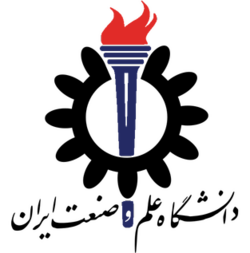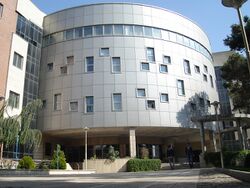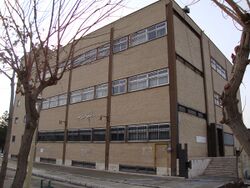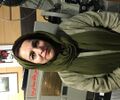Iran University of Science and Technology
Topic: Organization
 From HandWiki - Reading time: 8 min
From HandWiki - Reading time: 8 min
 | |
| Motto | Nothing is Impossible |
|---|---|
| Type | Public |
| Established | 1929 |
| Endowment | United States dollar 68.557 million (2019)[1] |
| President | Jabbar Ali Zakeri |
Academic staff | 430[2] |
| Students | 11,957 (2015)[3] |
| Undergraduates | 5,525 |
| Postgraduates | 5,445 |
| 987 | |
| Location | , Tehran province , [ ⚑ ] : 35°44′32.77″N 51°30′7.99″E / 35.7424361°N 51.5022194°E |
| Campus | Urban, 104 acres (42 ha) |
| Nickname | Elmos |
| Website | www.iust.ac.ir |
The Iran University of Science and Technology (IUST) (Persian: دانشگاه علم و صنعت ایران, Danushgah-e 'lâm vâ Sân't-e Iran) is a research institution and university of engineering and science in Iran. The university is home to 15 faculties offering undergraduate and postgraduate degrees in a wide range of engineering-based subjects as well as maths, physics, and department of foreign languages. In 1995 IUST awarded Iran’s first PhDs in materials, metallurgical and traffic engineering. IUST is the only university in the Middle East which has a school of railway engineering and a school of progress engineering. It is also the only university in Iran which has a school of automotive engineering. There are also 12 research centres, nine centres of excellence and 19 specialised libraries as well as four satellite campuses in other parts of the country.[4] IUST is located on Hengam Street in the Narmak neighborhood in northeast Tehran. IUST and its surrounding communities provide a cultural and recreational environment suited to the work of a major research institution.
According to the results of 2016 Times Higher Education World University Rankings, Iran University of Science and Technology stands as the "First University of the Country", 57th among Asian Universities and 457th among World Universities.[5] QS World University Rankings 2016–2017 has announced Iran University of Science and Technology (IUST) as the Second University of Iran and 491–500 among World Universities.[6] The 20,000[7] capacity IUST Stadium, which is used mostly for association football, is their main sports venue.
Jabbar Ali Zakeri is the dean.
History
Iran University of Science and Technology was founded in 1929 as the first Iranian Institution to train engineers, named the Governmental Technical Institute. Soon it was named "Honarsaraye Ali"—Advanced Art College in English.
In 1932, the first iranian graduated in Machine Engineering and in 1935 the first iranian graduated in Chemical Engineering.
In 1958, the Institute started to enroll students for Masters programs under the name of Tehran Institute of Technology (TIT).
In 1963, the Institute transferred to its current location in Narmak in northeast Tehran.
In 1972, the title of the college upgraded to the Iran Faculty of Science and Technology due to the growth of the institute by the Ministry of Sciences. The faculty offered four-year bachelor's degrees in most areas of engineering and it is the first and for many years the only engineering university that consist of School of Architecture in the country.
In 1978, it was granted University Status by the Ministry of Sciences. Since then the institute was named Iran University of Science and Technology.
In 1990 it admitted students to Ph.D. programs in Civil Engineering and Materials Engineering fields. In 1995, IUST awarded the first Ph.D. degrees in Iran in the fields of Materials Engineering, Metallurgical Engineering and Traffic Engineering.
In 2009, Iran's Ministry of Science, Research and Technology announced IUST as one of the country's "8 Mother Universities".
The main campus has 15 faculties and three other departments with 380 members of the academic board. On the main campus, 9,000 students are studying in 90 fields of engineering and sciences, out of which 2,000 are M.Sc. and 546 are Ph.D students. Over 50,000 students have graduated since 1932.
Campus
The main campus is located in the northeast of Tehran, expanded in 104 acres (42 ha). The campus includes faculty buildings, research centers, the main library, residential halls, the mosque, administrative buildings, sport playgrounds and covered spaces for sports such as football stadium, volleyball, basketball, and tennis courts.
IUST has four other campuses in the cities of Arak, Behshahr, Damavand, and Noor; the latter two are in progress.
Academics
IUST has 15 schools, 44 instruction groups, and 83 fields of study. Over 5,500 students study in the B.Sc program, over 5,400 students are studying in M.Sc. and over 940 are doing Ph.D. disciplines.
School of Electrical Engineering[8]
- Departments:[9]
- Electronic
- Bioelectrical Engineering
- Communication
- Power
- Control
School of Mechanical Engineering[10]
- Departments:[11]
- Solid Mechanics
- Fluid Mechanics
- Production and Manufacturing
- Aerospace Engineering
- Biomechanics
School of materials science[12]
- Departments:[13]
- Casting
- Industrial Metallurgy
- Extractive Metallurgy
- Ceramic
- Extraction of Metals
- Biomaterial
- Ceramic
School of Civil Engineering[14]
- Departments:[15]
- Environmental and Water Resources Engineering
- Geotechnical and Geo-environmental Engineering
- Highway Engineering
- Structural Engineering
- Transportation Engineering and Planning
- Geomatics Engineering
School of Industrial Engineering[16]
- Departments:[17]
- Industrial Engineering
- Systems Engineering
- Productivity Management
Other schools:
- School of Progress Engineering
- School of Automotive Engineering
- School of Railway Engineering
- School of Mathematics
- School of Chemistry
- School of Chemical, Petroleum, and Gas Engineering
- School of New Technologies
- School of Physics
- School of Computer Engineering
- School of Architecture and Environmental Design
Departments:
- Department of Physical Education & Sport Sciences
- Department of Foreign Languages
Extracurricular activities and association
The most important associations in Iran University of Science and Technology are:
- Student's Theater association
- Student's Music association
- Student's Literature association
- Student's Film association
Research
Advanced and High-Tech Research Activities at IUST include:
- Hydrostructures at the Department of Civil Engineering
- Electronics at the Department of Electrical Engineering
- Field of Advanced Materials at the Department of Materials Science and Metallurgical Engineering
- Nano Technology as interdepartmental research
- Bio-technology in the Department of Medical Engineering
- Hydrodynamics, experimental and numerical fluid dynamics research laboratory at the Department of Mechanical Engineering
The University Research Centers include:
- Architecture Research Center
- Automotive Research Center
- Cement Research Center
- Center of Excellence in Experimental Solid Mechanics and Dynamics[18]
- Center of Excellence in Islamic Architecture[19]
- Electronic Research Center[20]
- Green Research Center
- Information Technology Research Center
- Iran Composites Institute
- Materials Research Center
- Research Center for ICT Strategic and International Studies[21]
World rankings
| University rankings | |
|---|---|
| Iran University of Science and Technology | |
| Global – Overall | |
| ARWU World[22] | 901-1000 (2020) |
| CWTS World[23] | 386 (2020) |
| QS World[24] | 601–650 (2021) |
| THE World[25] | 501–600 (2021) |
| USNWR Global[26] | 904 (2021) |
Times Higher Education
- 2020–2021: National Rank: 6,[27] Rank in Asia: 87
- 2016–2017: National Rank: 1[28]
- 2015–2016: National Rank: 1, Rank in Asia: 57, International Rank: 475[29]
- 2014–2015: National Rank: 3, Rank in Asia: 69[30]
According to QS World University Rankings 2016–2017 Iran University of Science and Technology (IUST) ranked as the second university of Iran after Sharif University of Technology and 491–500 among world universities.[31]
Iran University of Science and Technology (IUST) ranked 436th among World universities and 78th in Mathematics and computer science according to 2011–2014 CWTS Leiden Ranking.[32]
In 2017, the U.S. News & World Report ranked IUST Engineering Sciences 113th among world universities. Also, Materials Science of IUST ranked 169 among World Universities.[33]
According to ShanghaiRanking's Global Ranking of Academic Subjects 2017, IUST has been ranked 101–150 among world universities in Metallurgical Engineering[34] and also 151–200 in Mechanical Engineering[35] and Civil Engineering.[36]
U.S. News & World Report[37]
- 2020 Best Global Universities Ranking
- Global Ranking: 870
- Engineering : 180
- Chemistry: 624
- Civil Engineering : 88
- Materials Science : 280
- Mechanical Engineering : 98
Notable people
Presidents
| Chancellor | Tenure | Alma mater | Speciality |
|---|---|---|---|
| Jalil Shahi | 1978-1980 | Civil Engineering | |
| Ebrahim Esrafilian | 1980-1981 | Mathematics | |
| Ebrahim Sanaei | 1981-1982 | Civil Engineering | |
| Ahad Kazemi | 1982-1983 | Electrical Engineering | |
| Ebrahim Sanaei | 1983-1984 | Civil Engineering | |
| Mohammad Zahabioun | 1984–1985 | Industrial Engineering | |
| Abbas Shoulaei | 1985-1987 | Electrical Engineering | |
| Ahad Kazemi | 1987-1989 | Electrical Engineering | |
| Abbas Taeb | 1989-1993 | Chemical Engineering | |
| Mahmoud Mollabashi | 1983-1997 | Physics | |
| Seyed Javad Azhari | 1997-2001 | Electrical Engineering | |
| Seyed Mohammad Shahrtash | 2001-2004 | Electrical Engineering | |
| Seyed Mohammad Taghi Salehi | 2004-2005 | Materials | |
| Mahdi Bidabadi | 2005-2006 | Mechanical Engineering | |
| Mohammad Jabalameli | 2006-2013 | Industrial Engineering | |
| Mohammad Ali Barkhordari | 2013-2017 | Civil Engineering | |
| Jabbar Ali Zakeri | 2017–current | Civil Engineering |
Notable faculty members [38]
| Name | Alma mater | Speciality | Profile |
|---|---|---|---|
| Ali Kaveh | Civil Engineering | google scholar | |
| Jalal Hedjazi | Metallurgy & Materials Engineering | profile | |
| Farrokh Hojjat Kashani | Electrical Engineering | profile | |
| Toraj Mohammadi | Chemical Engineering | google scholar | |
| Majid R. Ayatollahi | Mechanical Engineering | google scholar | |
| Mahmood M. Shokrieh | Mechanical Engineering | google scholar | |
| Vahak Kaspari Marghussian | Metallurgy & Materials Engineering | profile |
Notable alumni
Politics and government
- Mahmoud Ahmadinejad (B.S., M.S., PhD. 1997) - sixth President of Iran, and former Mayor of Tehran
- Hamid Behbahani (B.S.) - former Iranian Ministry of Science, Research and Technology (Iran)
- Kamran Daneshjoo (B.S.) - former Iranian Ministry of Science, Research and Technology (Iran)
- AbdolReza Sheikhol Eslami (B.S., M.S., PhD.) - former Iranian Minister of Employment
- Mohammad Hossein Saffar Harandi (B.S.) - former Iranian Ministry of Culture and Islamic Guidance
- Seyyed Kazem Vaziri Hamaneh (B.S.) - former Iranian Ministry of Oil
- Mohsen Rezaee (B.S.) - former Chief Commander of the IRGC, and secretary of the Expediency Discernment Council of the Islamic Republic of Iran
- Alireza Ali Ahmadi (B.S.) - former Iranian Minister of Education, former president of Payame Noor University
- Mohammad Soleimani (B.S.) - former Ministry of Information and Communications Technology of Iran
- Mehdi Ghazanfari (B.S. 1986) - former Iranian Ministry of Industry, Mine and Trade and former Ministry of Commerce of Iran
- Bahman Eshghi (B.S.) — Secretary-General of Tehran Chamber of Commerce, Industries, Mines, and Agriculture
Business
- Alireza Nasiri (B.S. 1993) - founder of online degree programs in University of Tehran and father of commercial forestation in Iran
Academia
- Abdollah Jasbi (B.S.) - former president of Islamic Azad University
- Mohammad Ali Barkhordari (B.S.) - professor of Civil Engineering, former president of Yazd University, University of Zanjan, and Iran University of Science and Technology
- Sayyed Mahdi Abtahi (B.S.) - professor of Civil Engineering, president of Isfahan University of Technology
- Jalil Shahi (B.S.) - professor of Civil Engineering, founder and former president of Yazd University, and former president of Iran University of Science and Technology
- Mohammad Bagher Niv (B.S.) - The first graduate of engineering in Iran
Film, television, radio, popular culture
- Tahmineh Milani (B.S. 1986) - Iranian film director
- Homayoun Khorram (B.S.) - Iranian musician, composer, violinist, and a member of the high council of Iran's House of Music
Writing and journalism
- Touka Neyestani (B.S.) - Iranian political cartoonist
- Ali Abolhassani (B.S. 1975) - Iranian contemporary historiograph
- Mohammad Reza Sarshar (B.S.) - Iranian author and novelist
Mahmoud Ahmadinejad: sixth President of Iran, and former Mayor of Tehran
See also
- List of Iranian Research Centers
References
- ↑ "Financial Information". Fars News. https://www.farsnews.com/news/13971010000211.
- ↑ http://roundranking.com/profillepage/IranUniversityofScience&Technology.html
- ↑ http://www.iust.ac.ir/page.php?slc_lang=fa&sid=1&slct_pg_id=17
- ↑ https://www.timeshighereducation.com/world-university-rankings/iran-university-science-and-technology#ranking-dataset/589595
- ↑ https://www.timeshighereducation.com/world-university-rankings/2016/world-ranking#!/page/0/length/25/country/30/sort_by/rank_label/sort_order/asc/cols/rank_only
- ↑ http://www.topuniversities.com/university-rankings/world-university-rankings/2016
- ↑ http://www.worldstadiums.com/middle_east/countries/iran.shtml
- ↑ https://ee.iust.ac.ir/
- ↑ http://ee.iust.ac.ir/page/8843/Department-Faculty-Members
- ↑ http://mech.iust.ac.ir/en
- ↑ http://mech.iust.ac.ir/page/805/Academic-Groups
- ↑ http://meteng.iust.ac.ir/en
- ↑ http://meteng.iust.ac.ir/en
- ↑ http://civil.iust.ac.ir/en
- ↑ http://www.iust.ac.ir/content/768/Area
- ↑ http://ie.iust.ac.ir/en
- ↑ http://ie.iust.ac.ir/page/8995/Study-Majors-and-Degrees
- ↑ http://www.iust.ac.ir/index.php?slc_lang=en&sid=71
- ↑ http://www.iust.ac.ir/index.php?slc_lang=en&sid=89
- ↑ http://erc.iust.ac.ir/
- ↑ http://ict-sis.iust.ac.ir/
- ↑ Academic Ranking of World Universities 2020, Shanghai Ranking Consultancy, http://www.shanghairanking.com/ARWU2020.html, retrieved 24 September 2020
- ↑ CWTS Leiden Ranking 2020, Centre for Science and Technology Studies, Leiden University, https://www.leidenranking.com/ranking/2020/list, retrieved 24 September 2020
- ↑ QS World University Rankings® 2021, Quacquarelli Symonds Limited, https://www.topuniversities.com/university-rankings/world-university-rankings/2021, retrieved 24 September 2020
- ↑ World University Rankings 2021, THE Education Ltd, https://www.timeshighereducation.com/world-university-rankings/2021/world-ranking#!/page/0/length/25/sort_by/rank/sort_order/asc/cols/stats, retrieved 2 September 2020
- ↑ Best Global Universities in Iran, U.S. News & World Report, https://www.usnews.com/education/best-global-universities/iran, retrieved 24 September 2020
- ↑ https://www.timeshighereducation.com/world-university-rankings/2021/world-ranking#!/page/0/length/25/locations/IR/sort_by/rank/sort_order/asc/cols/stats
- ↑ https://www.timeshighereducation.com/world-university-rankings/2017/world-ranking#!/page/0/length/25/country/2388/sort_by/rank_label/sort_order/asc/cols/rank_only
- ↑ https://www.timeshighereducation.com/world-university-rankings/2016/world-ranking#!/page/0/length/25/country/30/sort_by/rank_label/sort_order/asc/cols/rank_only
- ↑ https://www.timeshighereducation.com/world-university-rankings/iran-university-science-and-technology#ranking-dataset/128783
- ↑ http://www.topuniversities.com/university-rankings/world-university-rankings/2016
- ↑ http://www.leidenranking.com/ranking/2016/list
- ↑ https://www.usnews.com/education/best-global-universities/iran-university-science-technology-505518
- ↑ http://www.shanghairanking.com/Shanghairanking-Subject-Rankings/metallurgical-engineering.html
- ↑ http://www.shanghairanking.com/Shanghairanking-Subject-Rankings/mechanical-engineering.html
- ↑ http://www.shanghairanking.com/Shanghairanking-Subject-Rankings/civil-engineering.html
- ↑ https://www.usnews.com/education/best-global-universities/iran-university-science-technology-505518
- ↑ http://www.iust.ac.ir/page.php?slc_lang=fa&slct_pg_id=7879
External links
 KSF
KSF










